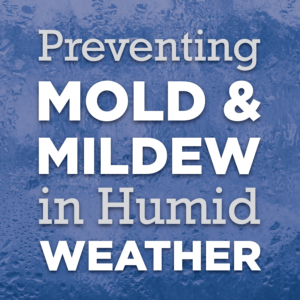Mildew and Mold Prevention for Humid Weather
 Humidity can cause a number of problems as well as serious health concerns. For building and facility managers, humidity also brings about the threat of mold or mildew.
Humidity can cause a number of problems as well as serious health concerns. For building and facility managers, humidity also brings about the threat of mold or mildew.
To keep the indoor air quality of your facility high and to prevent potentially dangerous conditions for personnel and visitors, it’s important to take the proper precautions to prevent mold and mildew in humid weather.
To limit the instance of mold or mildew in your facility, follow these helpful facility maintenance tips.
How Does Humidity Cause Mold and Mildew?
Water is a vital ingredient for mold or mildew to grow. A high relative humidity indicates a high level of moisture in the air. That’s why on hot, humid days the air feels thick or heavy, and also why mold and mildew grows easily in showers and locker rooms.
When warm, humid air comes in contact with a surface that’s cooler than the surrounding air, condensation can occur. When moisture accumulates on porous surfaces, it can cause mold to form.
That’s why keeping the relative humidity inside your building low is important for mold and mildew prevention.
How to Prevent Mold and Mildew from Forming
Keep Air Cool
Keeping the air inside your building cool is a great way to reduce airborne water vapor. It also makes the building more comfortable for you, your staff, and your visitors. The most common way to fill your building with fresh, cool air is by using an HVAC system or an air conditioning unit.
Increase Airflow
Another benefit of an HVAC system or air conditioner is that, in addition to providing cool air, it helps increase airflow. However, you can also increase the flow of air inside your building by using fans and keeping internal doors open. While this helps to keep fresh air coming into the building and prevents a room from filling with air that’s gone stale, it also makes it more difficult for moisture to accumulate and cause mold or mildew.
Use a Dehumidifier
If you frequently experience a humidity problem in only one area of your building, then it might be more cost-effective to install a dehumidifier in that area than to adjust the entire HVAC system or install multiple fans.
A dehumidifier is a powerful tool that allows you to easily regulate the relative humidity in a room. However, keep in mind that the larger the room, the more air that will need to be processed by the system.
Heat the Floor
While adding heat might seem counterintuitive, it’s actually an effective way to prevent condensation from forming on the floors or walls in below-ground areas or close to the foundation where temperatures are usually much cooler than the outside air.
As you read above, warmer air that comes in contact with cooler surfaces can result in condensation which can lead to mold.
Remove Porous Materials
One of the easiest ways to prevent mold and mildew in humid weather is to remove porous materials. While this might not be practical to execute for your entire building, it may be useful to think about targeting areas that are likely to be exposed to water vapor. One area you might want to target could be by the exterior doorways where humid outside air can enter the building.
Another area that should be free of porous surfaces, which can be made safer with non-porous materials. High-density polyethylene (HDPE) is a mold- and mildew-resistant material that’s perfect for bathroom partitions and vanities. It can also be used for lockers in lockers rooms, especially if your traditional lockers are growing mold.
To learn more about HDPE solutions and how they can help to prevent mold and mildew in your facility, contact us at Scranton Products today.



